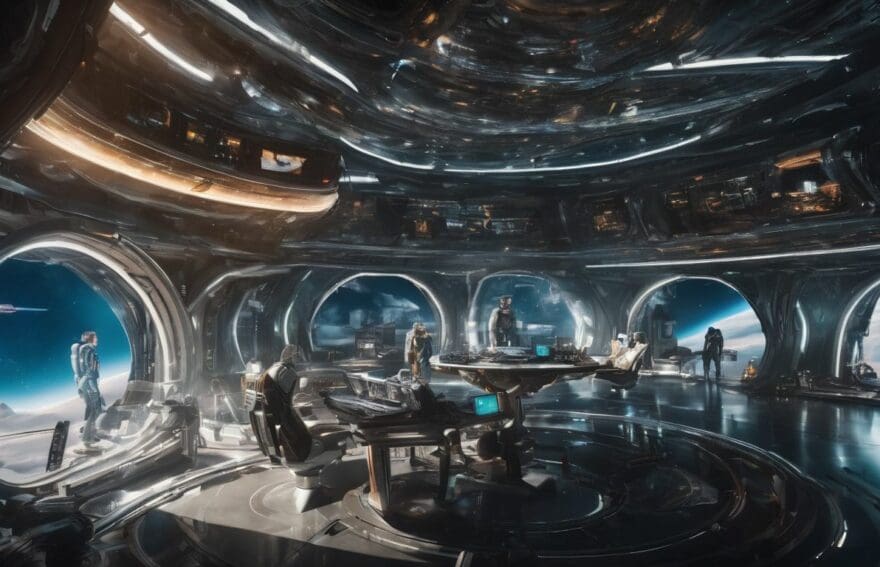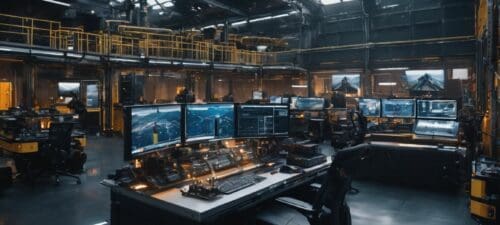Oxygen Not Included: The Challenge of Space Colony Survival

Updated On: November 18, 2025 by James Connolly
Endeavouring to maintain a thriving space colony in Oxygen Not Included can be an absolute pickle, can’t it? One finds oneself on the precipice of disaster with each gasp that your Duplicants snatch from the jaws of an unforgiving environment.
With the game’s complex underpinnings, such as fluid dynamics at work, charting a course towards sustainability may seem like a herculean task. Rest assured, our guide brims with sage advice and actionable tips aimed at transforming your beleaguered settlement into a flourishing interstellar haven.
Steer clear of letting your community dwindle; let us embark on this journey together!
Overview of Oxygen Not Included
In the captivating world of Oxygen Not Included, we don the proverbial hard hat of cosmic architects, embracing a colossal endeavour: to carve out a sanctuary for survival in the depths of an alien asteroid.
Here, we’re charged with shepherding our peculiar tribe of duplicants – quirky and endearing clones who depend on us for their every whim and need. It’s not merely about laying bricks and mortar; this base-building escapade is a ballet of precision and foresight where oxygen flow, cosy warmth, hearty meals, and high spirits are all at our fingertips.
Each choice subtly nudges the intricate web that sustains our otherworldly oasis.
Our role as custodians calls upon us to wield science like virtuosos. We’re tasked with overseeing life support systems that hum away tirelessly to delving into layers of resource management puzzling enough to mystify even the most adept tacticians – this game keeps one perennially perched on tenterhooks with its rigorous tactical conundrums.
Together we must learn to deftly weave through a tapestry teeming with tasks and technology; only then can our subterranean paradise stand tall against relentless environmental threats and resources that ebb away like sand through fingers.
Presently, let us delve into how these formidable trials may be met boldly within the unforgiving confines of Oxygen Not Included.
Unique Challenges of Space Colony Survival
Surviving in an alien environment presents unique challenges such as limited resources, environmental hazards, and managing duplicant needs. These obstacles require intense decision-making and resource balancing to ensure the colony’s survival.
Limited resources
In Oxygen Not Included, Survival is contingent upon efficiently managing limited resources. Water, essential for growing crops and sustaining life, must be carefully allocated to ensure the colony’s survival.
Players also need to balance oxygen production against the need for power and space while navigating scarcity in a harsh alien environment.
To survive in Oxygen Not Included, players must overcome challenges not only through strategic decisions but also by finding innovative ways to address limited resources. For instance, they have to manage water usage between various necessities such as crop growth and oxygen production.
Environmental hazards
Expanding on the challenges faced in a space colony, environmental hazards pose significant threats to survival. Players must contend with dangers such as exposure to extreme temperatures, toxic gases, and frequent meteor showers.
These hazardous conditions can lead to critical infrastructure damage and endanger the lives of colonists. Managing these risks effectively is crucial for sustaining life within the colony.
To mitigate these environmental hazards, players must construct protective structures and advanced life support systems capable of withstanding harsh extraterrestrial conditions. Additionally, developing technologies for climate control and atmospheric regulation becomes essential for ensuring the safety and well-being of the colony’s inhabitants.
Managing duplicant needs
Duplicants in Oxygen Not Included have various needs that players must manage to ensure the colony’s survival. They require food, water, and rest to maintain their health and productivity.
Additionally, maintaining a comfortable temperature and addressing stress levels are crucial for their well-being.
Players can assign specific tasks to duplicants based on their strengths and weaknesses. Balancing these needs among multiple duplicants while also managing resources adds a layer of complexity to the game.
Strategies for Survival
We will discuss efficient resource management, prioritising tasks, and building a sustainable base to help you thrive in the challenging world of Oxygen Not Included. Curious to know more? Keep reading!
Efficient resource management
To survive in Oxygen Not Included, efficient resource management is essential. Balancing the colony’s needs for oxygen, food, water, and power requires careful planning and strategic decision-making.
Duplicants must be assigned to tasks based on their skills to maximise productivity. Monitoring resources such as algae, water, and power becomes critical as the colony expands. Utilising renewable sources of energy like natural gas or solar power can help sustain the colony long-term.
Players often prioritise research into technologies that allow for more efficient resource production and management. Building storage solutions near production facilities ensures a steady supply of resources while minimising duplicant travel time.
Additionally, creating redundancy in critical systems prevents catastrophic failures that could spell doom for the entire colony.
Prioritising tasks
When playing Oxygen Not Included, we must prioritise tasks to ensure the survival of our colony. Assessing the immediate needs of our duplicants is crucial – providing oxygen, managing food supplies, and maintaining a stable environment are essential for their well-being.
Our first step should be establishing efficient resource management to meet these basic needs. By assigning priorities to tasks such as gathering resources, repairing equipment, and constructing essential facilities, we can guarantee that the most critical functions are consistently maintained.
Once we have established efficient resource management systems, we can focus on building a sustainable base. This involves strategically placing vital structures and planning for future expansions.
By taking into account factors such as power distribution and water supply early on, we set ourselves up for success as our colony grows in complexity and size.
Building a sustainable base
After prioritising tasks comes the crucial phase of building a sustainable base. In Oxygen Not Included, sustaining your colony is paramount for survival. Managing resources like water and oxygen becomes a primary concern.
Players need to ensure that their base is efficiently designed to support the needs of duplicants, including providing adequate living space and managing waste. Balancing power production and consumption also plays a significant role in creating a sustainable base.
It’s essential to carefully plan and build infrastructure such as water purification systems, airlocks, and renewable energy sources. By focusing on efficient resource management and environmental sustainability, players can create a robust foundation to support their colony’s growth while tackling the challenges presented by the harsh extraterrestrial environment within Oxygen Not Included.
Expanding Your Colony
Unlocking new technologies and managing larger populations are essential for expanding your colony in Oxygen Not Included. As you grow, be prepared to deal with new challenges that come with a thriving extraterrestrial settlement.
Unlocking new technologies
To progress and expand the colony, players must unlock new technologies, which offer essential tools and structures for survival. By delving into science mastery, new research options become available for improving resource management and sustaining life in the harsh space environment.
As players manage duplicants’ needs and navigate through environmental hazards, unlocking new technologies becomes a critical aspect of overcoming challenges and building a thriving extraterrestrial settlement.
Players experience intense decision-making as they prioritise technological advancements that can enhance their colony’s functionality. Additionally, by managing larger populations effectively while dealing with new challenges, such as alien life forms inside the asteroid, players are constantly pushed to adapt and innovate in their quest for survival.
Managing larger populations
To manage larger populations in Oxygen Not Included, players must carefully balance the needs of each duplicant as the number of inhabitants increases. It becomes crucial to efficiently allocate resources such as food, water, and oxygen to support the growing colony.
Additionally, expanding the infrastructure and facilities while maintaining a sustainable environment is vital for accommodating new members. As more duplicants join the colony, players face intensified challenges in maintaining a harmonious balance between supply and demand within their ever-growing space community.
Players will need to develop effective strategies for managing larger populations by prioritising tasks and continuously expanding their base’s capabilities. Unlocking new technologies not only facilitates resource management but also helps in tackling the complexities that come with housing a greater number of duplicants.
Dealing with new challenges
Dealing with new challenges in Oxygen Not Included keeps players on their toes. Adapting to the ever-changing environment of an alien asteroid demands quick thinking and strategic decision-making.
Learning to overcome new life forms and harness space technology becomes essential for survival, requiring us to constantly innovate and evolve our colony management strategies.
Expanding our knowledge of fluid dynamics and mastering the art of sustaining life in a harsh extraterrestrial setting is crucial as we encounter fresh obstacles along the way. Adapting to these challenges allows us to push the boundaries of our skills, making each playthrough a unique experience that tests our abilities as space colony managers.
Conclusion
Surviving in Oxygen Not Included demands efficient resource management. Players must prioritise tasks to maintain a sustainable base. Expanding the colony requires unlocking new technologies and managing larger populations.
They must also confront new challenges as they push the boundaries of their extraterrestrial living.
FAQs
1. What is ‘Oxygen Not Included’ about?
‘Oxygen Not Included’ is a survival simulation game where players manage a space colony and make intense decisions to keep their crew alive in extraterrestrial living conditions.
2. How do you play the survival game?
You play by carefully managing your crew, making strategic expansion plans, and overcoming balancing challenges to thrive in this base-building game set in space exploration.
3. Can you expand your space colony in the game?
Yes, as part of the gameplay, you can plan and execute expansion of your space colony while ensuring the survival of your inhabitants against various challenges.
4. Is there a roadmap for new content on ‘Oxygen Not Included’?
The developers often provide a game expansion roadmap which details upcoming features that enrich the experience of this intense decision-making survival challenge.
5. Why is ‘Oxygen Not Included’ considered a tough survival simulation?
It’s known for its complex systems that require smart crew management and resource control within an unforgiving environment where every choice can impact your colony’s success or demise.









